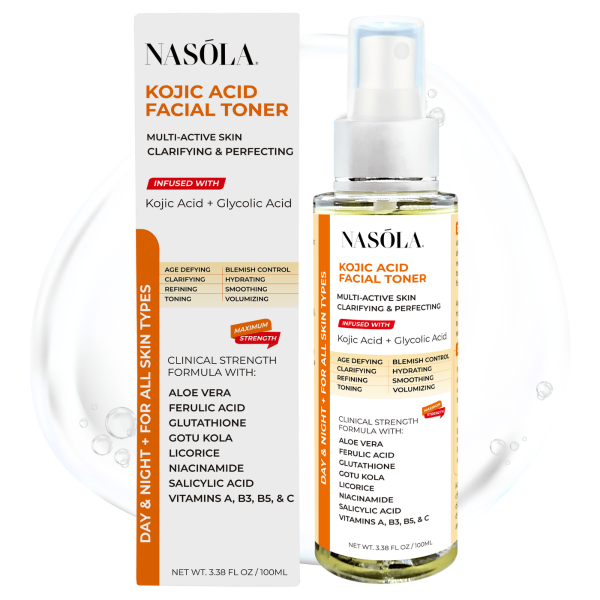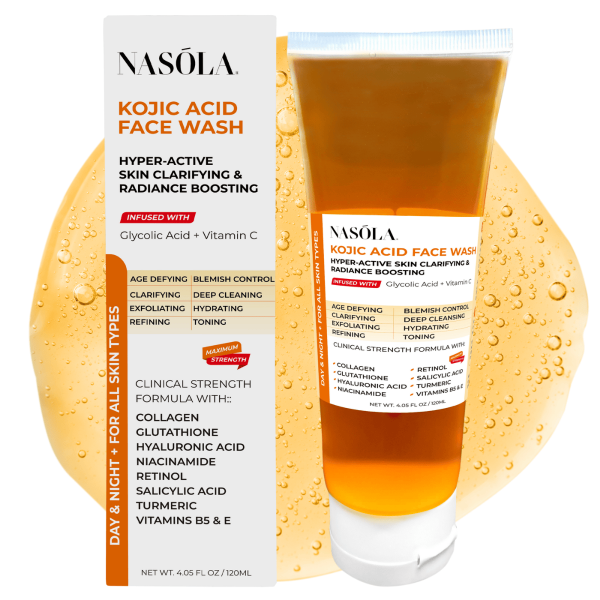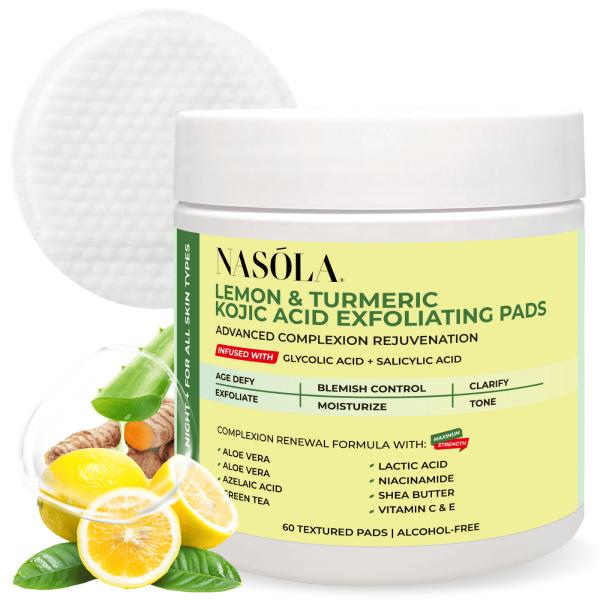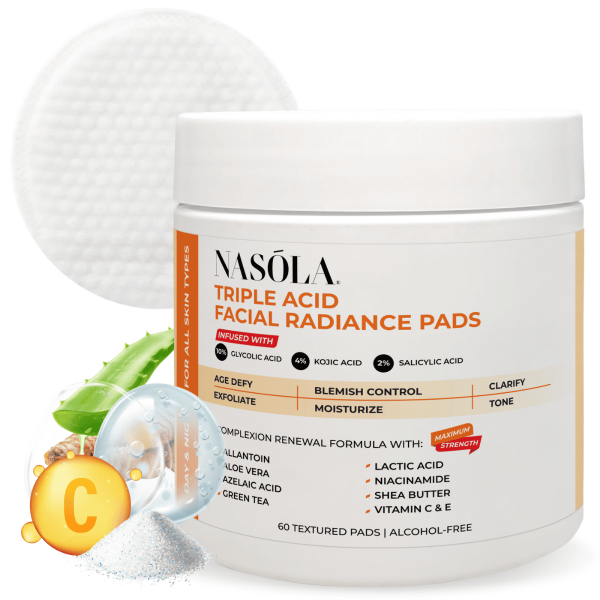Your skin has stories—sometimes those stories are joyful, glowing, and radiant… and other times, well, they’re tinged with redness, burning, and unexpected breakouts.
Let me guess—you tried a skincare cocktail that seemed promising but left you regretting every drop.
That’s probably how you landed here, searching for exactly this: what not to mix with glycolic acid. And trust me, you’re not alone. Glycolic acid is loved for a reason—it smooths, exfoliates, and brightens like a charm.
But… ONLY when not sabotaged by the wrong partner in your skincare routine.
In this post, I’ll break down exactly which ingredients don’t play well with glycolic acid, why your skin might react badly, and how to still chase that glow (the smart way).
Plus, I’ll share lifesaving product swaps—like the gentle and effective Nasola Kojic Acid Face Wash—to help you avoid mishaps while still getting every drop of benefit.
Ready to protect that beautiful skin of yours?
Let’s go!
- What Not to Mix With Glycolic Acid: Top Skincare Combos to Avoid
- Why You Should Avoid Certain Ingredients With Glycolic Acid
- Layering Tips: What Not to Mix With Glycolic Acid for a Balanced Routine
- Safe and Effective Alternatives to Glycolic Acid Combinations
- How to Safely Incorporate Glycolic Acid Into Your Routine
- Extra Layer of Protection: Night Routine Dos and Don’ts With Glycolic Acid
- Conclusion
- Frequently Asked Questions
What Not to Mix With Glycolic Acid: Top Skincare Combos to Avoid
Mixing the wrong ingredients with glycolic acid can take your glow goals and flip them upside down. Think of it like hosting a dinner—some guests sit, chat, and sip wine while others flip tables and start fights.
In skincare terms? Redness, irritation, and compromised skin barriers.
Below are the ingredient combinations that can ruin the show. If your goal is smooth, calm, confidently radiant skin, treat this like your skincare bible.
And if you’re looking for smart workarounds, you’ll find gentle heroes here to save the day too—like Nasola Triple Acid Facial Radiance Pads or Nasola Kojic Acid Facial Toner.
Retinol and Glycolic Acid: Why This Combo Is a No-Go
Mixing glycolic acid and retinol is like doubling down on intensity without a safety net. Both are powerful on their own, stimulating cell turnover and treating a range of skin issues—but when combined?
Whoaa. Irritated, burning skin ahead.
Because they both promote exfoliation, using them together overwhelms your skin’s natural barrier. The result? Dryness, peeling, and a wildly unstable complexion.
Instead, try this gentle balance:
- Use glycolic acid in the morning and retinol at night (or alternate days).
- Hydrate religiously. Barrier-restoring ingredients are a must.
- Introduce one ingredient first, then build tolerance for the other.
- Consider glycolic blends like Nasola Triple Acid Facial Radiance Pads if you’re seeking a controlled exfoliating experience.
Rule of thumb: if your face is feeling hot, tight, or flaky—pause. Your glow can wait a day.
Vitamin C and Glycolic Acid: Timing Matters
Vitamin C and glycolic acid do not mix well in a single routine. You see, Vitamin C thrives in a certain pH environment—and glycolic acid completely disrupts that.
Mix them? You might make your pricey Vitamin C ineffective.
Even worse? You may trigger sensitivity and inflammation, especially if your skin is already prone to redness.
Here’s what to do instead:
- Use Vitamin C in the morning and glycolic acid at night.
- Opt for Vitamin C-free exfoliating products in your acid routine.
- Patch test any new combo before going full-face.
- Try pair-friendly options like the Nasola Lemon Turmeric Kojic Acid Exfoliating Pads, which offer brightening benefits, minus the chaos.
Using both? Cool… just not together.
Physical Exfoliants and Glycolic Acid: Double Trouble for the Skin
This pairing? Recipe for raw, flaming cheeks.
Glycolic acid already removes the dead layer of skin. So when you sweep in with a gritty scrub, you’re scrubbing fresh baby skin. Ouch.
Exfoliate smart instead:
- Ditch physical scrubs when using chemical exfoliants.
- Don’t use facial brushes immediately after glycolic application.
- Let glycolic acid do the heavy lifting.
- Choose a controlled exfoliator like Nasola Triple Acid Facial Radiance Pads that supports gentle peeling with precise formulation.
Your cheeks will thank you.
Why You Should Avoid Certain Ingredients With Glycolic Acid

Some powerhouse ingredients are like powerful spices. On their own? Stunning. Together? Your skin starts screaming. When using glycolic acid, every step of your routine matters—especially the “what comes after.”
Poor ingredient pairing can lead to barrier damage, increased sun sensitivity, and flare-ups of existing skin conditions.
Let’s unpack a few more combos that deserve red-flag status.
Salicylic Acid
Mixing salicylic acid with glycolic acid sounds appealing if you’re targeting acne + texture—but doubling exfoliators is risky.
Too much peeling = irritated, overly dry skin, flaking, and long-term barrier damage.
Instead:
- Use them on alternate days.
- Hydrate well before and after exfoliating.
- Choose pre-balanced formulas like Nasola Triple Acid Facial Radiance Pads which combine glycolic, lactic, and salicylic acids safely.
- Apply SPF regularly as this combo boosts sun sensitivity.
Balance > Brute force.
Niacinamide + Glycolic Acid: Use Carefully
Technically, niacinamide and glycolic acid aren’t mortal enemies—but using them together can “cancel out” their powers due to pH conflict.
Ah yes, chemistry class all over again.
What can you do?
- Space them out (Glycolic at night, Niacinamide in the AM).
- Choose gentle formulations that already considered pH balance.
- Avoid layering random serums with both ingredients.
- Use smart product swaps like Nasola Lemon Turmeric Kojic Acid Exfoliating Pads that contain brightening agents—without the drama.
Let them each shine… solo.
Benzoyl Peroxide and Glycolic Acid: Skin Barrier Alert
This combo is a big ol’ NO.
Period.
Benzoyl peroxide is harsh by nature. Pair it with glycolic and you’re practically inviting peeling, irritation, and stinging into your skincare routine.
Instead:
- Alternate usage (BP in the AM, glycolic in PM).
- Sandwich actives between calming, hydrating products.
- Stick with a mild face wash like Nasola Kojic Acid Face Wash, which keeps skin clean without being aggressive.
- Reset your moisture barrier before jumping back in.
If your skin’s acting up—you probably mixed these two.
Layering Tips: What Not to Mix With Glycolic Acid for a Balanced Routine
So now you know what not to mix with glycolic acid, but where does that leave your routine?
The good news? It’s NOT about subtracting everything. It’s all about timing, layering properly, and knowing which heroes complement this powerhouse.
Let’s fine-tune your ritual the right way.
Start With a Gentle Cleanser
Every strong act needs a soft opening.
A pH-balanced face wash gives glycolic acid the peace it needs to do its job without throwing your moisture balance off the rails.
That’s why I always recommend Nasola Kojic Acid Face Wash.
It’s:
- Packed with kojic acid to brighten dull skin.
- Free of sulfates, fragrances, and drying alcohols.
- Designed to prep your skin for glycolic acid without irritation.
- An effortless way to reduce discoloration and uneven tone.
Glycolic acid needs proper entry… this is it.
Toner Choices Matter
If your toner stings—ditch it.
Highly astringent or alcohol-based formulas after glycolic acid are like lemon juice on a paper cut. Instead, focus on toners that tone and brighten gently.
My go-to? Nasola Kojic Acid Facial Toner.
Here’s why it works:
- Calms freshly exfoliated skin using witch hazel + kojic acid.
- Brightens without heavy actives.
- Does not disrupt glycolic acid’s effects.
- Beautiful prep for hydration, serums, or makeup.
Toner is not optional—but it must be the right one.
Safe and Effective Alternatives to Glycolic Acid Combinations

Maybe you’re feeling… betrayed. You loaded your skincare shelf with actives only to learn they don’t mingle well.
Don’t worry. There is still SO much you can do.
These alternatives offer gentler paths to glow-town—especially if your skin gets jittery around potent combos.
Time to meet your kinder options.
Gentle Exfoliation with Built-in Balance
You don’t need eight vials to exfoliate.
Nasola Lemon Turmeric Kojic Acid Exfoliating Pads are perfect for:
- Glowy skin seekers who want less sting.
- Brightening without layering acids.
- Building tolerance slowly.
- Addressing dark spots over time.
They combine turmeric, kojic acid, and niacinamide in a skin-loving way your face will appreciate.
Brightening and Toning Without Overdrying
Not using glycolic acid every day? No problem.
Support in-between days with brightening and hydrating formulas.
Nasola Kojic Acid Facial Toner offers:
- A gentle pick-me-up for dull skin.
- Layering flexibility (won’t clash with actives).
- Lightweight hydration.
- Perfect pH for sensitive or combo skin.
It’s about synergy… not force.
How to Safely Incorporate Glycolic Acid Into Your Routine
The easiest way to get glycolic acid to work for you—not against you—is baby steps.
Don’t jump straight to the heavy-duty stuff every single day. Think technique. Think support. Keep it simple.
Here’s how:
- Use Nasola Triple Acid Facial Radiance Pads 2–3 times per week.
- Apply on clean, dry skin in the PM.
- Follow up with nourishing serum or cream.
- Always wear SPF during the day if using acids at night.
Less chaos. More glow.
Extra Layer of Protection: Night Routine Dos and Don’ts With Glycolic Acid

Nighttime routines deserve their own spotlight—especially when glycolic acid’s involved. Your skin heals while you sleep, making it the ideal time to let actives work their magic.
But—there’s a smart way to do this… and a way that completely wrecks the party. Let’s talk strategy.
Avoid Over-Layering at Night
Keep it minimal. Nighttime is not the place to become a chemist.
Simple layering rules:
- Start with cleansing (think Nasola Kojic Acid Face Wash).
- Apply glycolic acid next.
- Follow with calming toner (like Nasola Kojic Acid Facial Toner).
- Use one gentle serum or cream.
- Sleep, don’t worry.
Hit reset. Not overload.
Protect and Nourish With Buffering Moisturizers
Buffering is your skin-protecting BFF.
Moisturizers with ceramides, glycerin, or hyaluronic acid help ward off dryness after acids.
Pro tips:
- Opt for fragrance-free options.
- Apply to slightly damp skin.
- Avoid barrier disruptors (like facial oils with actives).
- Never skip this last layer—it keeps your glow going strong.
This step turns “Ahh!” into “Aaaahhh…”
Conclusion
Knowing what not to mix with glycolic acid is like discovering skin code—once you get it, your whole routine shifts. Instead of inflammation and guessing games, you’ll see real results without chaos.
Glycolic acid is ✨ amazing ✨—but only when used thoughtfully. By avoiding harsh clashes with retinol, Vitamin C, benzoyl peroxide, and over-exfoliating, you guard your glow with grace.
And with tiered support from trusted products like:
- Nasola Triple Acid Facial Radiance Pads
- Nasola Kojic Acid Facial Toner
- Nasola Lemon Turmeric Kojic Acid Exfoliating Pads
- Nasola Kojic Acid Face Wash
You’ll feel secure, supported, and radiant—because you finally listened to what your skin’s been asking all along.
Now go glow, and glow smart.
Frequently Asked Questions
You should avoid mixing glycolic acid with ingredients like retinol, salicylic acid, vitamin C, benzoyl peroxide, and niacinamide to prevent skin irritation and reduce the risk of ingredient conflict.
Yes, but timing matters. Glycolic acid works best in acidic conditions, while niacinamide prefers neutral pH. Use glycolic acid at night and niacinamide in the morning or space them out within one routine.
Safe products include calming, non-exfoliating formulas like the Nasola Kojic Acid Face Wash and Nasola Kojic Acid Facial Toner, which soothe and hydrate the skin post-exfoliation.
Only if they’re carefully formulated together. The Nasola Triple Acid Facial Radiance Pads are expertly balanced and include glycolic and salicylic acids for safe, effective exfoliation.
It’s best to start slow—2–3 times a week is ideal to see results without overwhelming your skin. Products like Nasola Lemon Turmeric Kojic Acid Exfoliating Pads are gentler for more frequent use.
Yes, nighttime is the best time to use glycolic acid as it may increase sun sensitivity. Layer with calm, supportive products like Nasola Kojic Acid Facial Toner.
Burning usually indicates overuse or improper layering with incompatible ingredients. Stop use, hydrate your skin, and reintroduce only when it’s back to normal.
Absolutely. Moisturizing helps reinforce your skin barrier. Use a fragrance-free moisturizer and consider layering over calming products like Nasola Kojic Acid Facial Toner.
Yes, especially if formulated correctly. Products like Nasola Kojic Acid Facial Toner combine kojic acid with complementary ingredients that won’t irritate.
You can, but ensure you wait at least 10–15 minutes after applying glycolic acid and follow with a hydrating primer to protect your freshly exfoliated skin.





